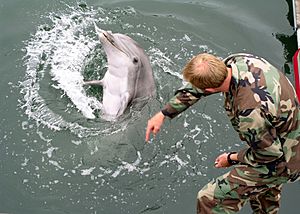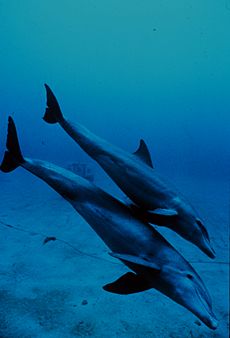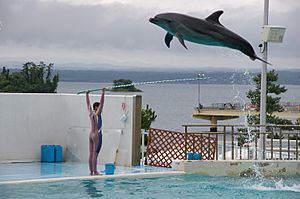Bottlenose dolphin facts for kids
Quick facts for kids Bottlenose dolphin |
|
|---|---|
 |
|
| Bottlenose Dolphin breaching in the bow wave of a boat | |
 |
|
| Size comparison against an average human | |
| Scientific classification | |
| Kingdom: | |
| Phylum: | |
| Class: | |
| Order: | |
| Family: | |
| Genus: |
Tursiops
|
| Species: |
T. truncatus
|
| Binomial name | |
| Tursiops truncatus Montagu, 1821
|
|
 |
|
| Bottlenose Dolphin range (in blue) | |
A bottlenose dolphin is a type of dolphin named for its snout, which looks like a bottle. Its actual nose for breathing is a hole on top of its head. Bottlenose dolphins are very smart. They are good hunters that mostly eat small fish.
Contents
- What Do Bottlenose Dolphins Look Like?
- How Are Bottlenose Dolphins Built?
- How Do Bottlenose Dolphins Sense the World?
- How Smart Are Bottlenose Dolphins?
- Dolphin Life Cycle
- What Do Bottlenose Dolphins Eat?
- How Do Dolphins Interact with Other Animals?
- How Do Humans and Dolphins Interact?
- Images for kids
- See also
What Do Bottlenose Dolphins Look Like?
Bottlenose dolphins are different shades of gray. They are darkest on top and almost white underneath. This special coloring, called countershading, helps them hide when they are swimming. It makes them hard to see from above or below.
Adult dolphins can be from 6.6 to 13.1 feet (2.0 to 4.0 m) long. They can weigh between 330 to 1,430 pounds (150 to 650 kg). Males are usually bigger than females. Dolphins living in warm, shallow waters are often smaller. Those in cooler, open ocean waters tend to be larger.
Bottlenose dolphins can live for over 40 years. Females often live 5 to 10 years longer than males. Very few dolphins, less than 2%, live past 60 years old. These dolphins can jump up to 20 feet (6.1 m) into the air. They use these jumps to talk to each other.
How Are Bottlenose Dolphins Built?
The bottlenose dolphin has long upper and lower jaws. These form its snout, also called a rostrum. They have 18 to 28 cone-shaped teeth on each side of their jaws. Their real nose is a blowhole on top of their head. It is almost in the middle, between their eyes. You can see the nasal septum when the blowhole is open.
The dorsal fin (on their back) and flukes (tail lobes) do not have bone or muscle. They are made of strong connective tissue. The flukes push the dolphin forward when it moves them up and down. The pectoral flippers (on the sides of the body) help the dolphin steer.
How Do Bottlenose Dolphins Sense the World?
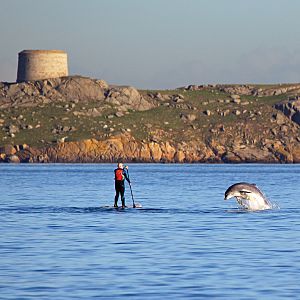
Dolphins in colder waters have more body fat and blood. This helps them dive deeper than those in warmer waters. About 18%–20% of a cold-water dolphin's weight is blubber (fat). Most studies on this have been in the North Atlantic Ocean.
Bottlenose dolphins usually swim at 3 to 7 miles per hour (4.8 to 11.3 km/h). They can also swim in short, fast bursts. These bursts can reach speeds of 18 to 22 miles per hour (29 to 35 km/h).
Dolphin Senses: Seeing, Hearing, and Tasting
Bottlenose dolphins use a type of sonar called echolocation to find food. They send out quick clicking sounds in a focused beam. Then, they listen for the echo. This echo tells the dolphin about the size, shape, speed, distance, and location of things in the water.
Bottlenose dolphins have very good eyesight. Their eyes are on the sides of their head. They have a special reflecting layer, called a tapetum lucidum, at the back of the retina. This helps them see well in dim light. Their horseshoe-shaped pupils help them see clearly both in the air and underwater.
Dolphins have a poor sense of smell. They do not have smelling nerves or brain parts for smell. Also, their blowhole closes when they are underwater.
Scientists think bottlenose dolphins can taste salty, sweet, bitter, and sour flavors. Some dolphins in captivity have shown they prefer certain types of fish. However, more research is needed to know if this is due to taste or something else.
How Do Dolphins Talk to Each Other?
Bottlenose dolphins talk using sounds and body language. Their body language includes jumping out of the water, snapping their jaws, slapping their tail on the surface, and bumping heads. Sounds and gestures help them keep track of other dolphins in their group. They also warn others about danger and nearby food.
Dolphins do not have vocal cords. They make sounds using six air sacs near their blowhole. Each dolphin has its own special whistle, called a signature whistle. Researchers from the Bottlenose Dolphin Research Institute (BDRI) in Sardinia, Italy, have shown how important these sounds are.
The musical whistle sounds help dolphins stay in touch. They also help them work together to hunt. The burst-pulsed sounds are more complex. They are used when dolphins might fight. Each dolphin makes these sounds, and the less dominant dolphins move away.
How Smart Are Bottlenose Dolphins?
Dolphin Thinking Abilities
Since the 1970s, scientists have studied how bottlenose dolphins think. This research looks at many things. It includes their ability to copy sounds and actions. They can also understand the order of events and learn artificial languages. Dolphins can remember things and watch their own behavior. They can tell what is alike and what is different. They also understand symbols for body parts. Dolphins can understand pointing and looking gestures from other dolphins or humans. They can even recognize themselves in a mirror and understand numbers.
Do Dolphins Use Tools?
Some wild bottlenose dolphins use tools. In Shark Bay, dolphins have been seen putting a marine sponge on their snout. They probably do this to protect it when they search for food on the sandy seafloor. A study in 2005 showed that mothers were most likely to teach this behavior to their young.
Near Adelaide, Australia, three bottlenose dolphins can "tail walk." They lift the top part of their bodies out of the water. Then, they push themselves along the surface with strong tail movements. In the 1980s, a female dolphin was kept at a local dolphinarium. Scientists think she copied the tail-walking from other dolphins that humans had taught. Two other wild adult female dolphins have now copied it from her.
A study by the University of Chicago showed that bottlenose dolphins can remember the whistles of other dolphins. They can remember them even after 20 years apart. Each dolphin has a unique whistle that acts like a name. This helps them keep strong social bonds.
Dolphin Life Cycle
How Do Dolphins Breathe and Sleep?
The bottlenose dolphin has one blowhole on top of its head. It has a hole and a muscular flap. The flap closes when the muscles relax and opens when they tighten. Dolphins choose when to breathe. They have to decide to go to the surface and open their blowholes to get air. Usually, dolphins surface two to three times per minute. But a dolphin can stay underwater for up to 20 minutes.
Dolphins sleep differently than humans. Their sleep cycle lasts about 8 hours in total. This is broken into sections of minutes to hours. While sleeping, they stay near the surface. Half of their brain stays active. This part controls surfacing and breathing. They swim slowly, which is called "logging." They sometimes close one eye.
How Do Dolphins Have Babies?
During the breeding season, male dolphins work hard to mate with females. They might fight other males. They might also herd females to keep them from other males. Sometimes, they even work together in teams to control the females.
Mating happens belly to belly. The gestation period (how long the baby is in the mother) is about 12 months. Babies can be born any time of year. But more births happen during warmer months. Twins are rare. Usually, only one calf is born in shallow water. Sometimes, another dolphin helps with the birth.
Newborn bottlenose dolphins are 2.6 to 4.6 ft (0.79 to 1.40 m) long. They weigh 20 to 66 lb (9.1 to 29.9 kg). Calves born in the Indo-Pacific are usually smaller. The mother can send milk from her mammary glands to help her calf start nursing quickly. The calf drinks milk for 18 months to up to 8 years. It stays close to its mother for several years after weaning (stopping milk). Females are ready to have babies between ages 5 and 13. Males are ready to be fathers between ages 9 and 14. Females have babies every two to six years.
How Do Dolphins Live in Groups?
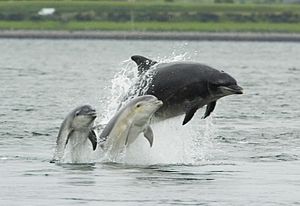
Adult male dolphins mostly live alone or in small groups of two or three. They join larger pods for short times. Adult females and young dolphins usually live in groups of up to 15. The size of these groups, and even the members, change often. This can happen daily or hourly. Smaller groups can join to form larger groups of 100 or more. Sometimes, they can even be over 1,000 dolphins. Their social life is similar to how elephants and chimpanzees live.
What Do Bottlenose Dolphins Eat?
How Do Dolphins Find Food?
A dolphin's diet is mainly small fish, crustaceans (like crabs), and squid. What they eat can change based on where they live. But many groups like fish from the mullet family, the tuna and mackerel families, and the drum and croaker families. The bottlenose dolphin's cone-shaped teeth are for grabbing food, not for chewing it.
Here are different ways dolphins hunt:
- When some dolphins find a school of fish, they work as a team. They herd the fish toward the shore. This helps them catch more fish for one meal.
- Other dolphins hunt alone. They often look for animals that live on the bottom of the sea.
- Sometimes a dolphin will hit a fish with its fluke (tail). This knocks the fish out of the water. This is called "fish whacking."
- "Strand feeding" is a special way of hunting used by dolphins near the coasts of Georgia and South Carolina. A group of dolphins will circle a school of fish. They trap the fish in a small whirlpool. Then, the dolphins charge at the fish. They push their bodies onto a mudflat, forcing the fish onto the mudflat too. The dolphins then crawl on their sides, eating the fish they pushed ashore. Finally, they flip back into the water.
- Mud plume feeding is seen in the Florida Keys. Some dolphins use this method to confuse fish. They create a U-shaped ring of mud. The fish swim into it. When the fish are confused, the dolphins swim in and eat them.
- In some parts of the Mediterranean Sea, bottlenose dolphins use human fishing areas. They go to fishing nets because they know many fish are there.
How Do Dolphins Interact with Other Animals?

Dolphins can be kind to other sea creatures. On Mahia Beach, New Zealand, in 2008, two pygmy sperm whales were stuck on the beach. Rescuers tried to help them four times. Then, a playful bottlenose dolphin named Moko arrived. After making sounds to the whales, Moko led them 660 ft (200 m) along a sandbar to the open sea. This saved them from dying.
Bottlenose dolphins can also act aggressively (try to harm) toward sharks and smaller dolphin species. At least one group, off Scotland, has attacked and killed harbor porpoises. Some scientists think dolphins do not always eat their victims. They might compete for food to show their power.
The bottlenose dolphin sometimes forms mixed groups with other dolphin species. This is especially true for larger species, like the short-finned pilot whale, the false killer whale, and Risso's dolphin. They also interact with smaller species, like the Atlantic spotted dolphin and the rough-toothed dolphin.
Who Hunts Dolphins?
Some large shark species hunt bottlenose dolphins. These include the tiger shark, the dusky shark, the great white shark, and the bull shark. They especially hunt young calves. Swimming in pods helps dolphins defend themselves better against predators. Bottlenose dolphins either use tricky moves to out-swim their predators. Or, they use "mobbing" techniques to hit the predator until it dies or runs away. Killer whales in New Zealand and Peru have been seen hunting bottlenose dolphins. But this seems rare. Other orcas may even swim with dolphins.
How Do Humans and Dolphins Interact?
Dolphins and People
Bottlenose dolphins sometimes show curiosity toward humans in or near water. Sometimes they rescue injured divers by bringing them to the surface. They also do this to help injured dolphins from their own group. In 2004, dolphins reportedly worked together to help four lifeguards in New Zealand. The lifeguards were swimming 330 ft (100 m) off the coast near Whangarei. A shark (thought to be a great white shark) came near them. Bottlenose dolphins herded the swimmers together. They surrounded them for 40 minutes, stopping the shark from attacking. They slowly swam to shore.
When dolphins swim near the shore, they can crash into boats. Researchers studied how bottlenose dolphins dive when boats were around and when they were not. Dolphins reacted more to tourist boats than fishing boats.
Dolphins can also live peacefully with humans. For example, in Laguna, Brazil, a group of bottlenose dolphins lives near the shore. Some of them work with humans. Fishermen know and have named some of the dolphins that help them. The dolphins help the fishermen by making a special body movement, like slapping their tail on the water. This shows the fishermen when fish are coming. The fishermen then cast their nets and catch more fish than without the dolphins' help. The dolphins are not trained to do this. This collaboration started before 1847. Mauritania, Africa, has similar cooperative fishing.
Many countries have businesses that offer "dolphin encounter" tours. The movie The Cove shows how dolphins are caught and sold to some of these companies (especially in Asia). The rest of the dolphin group is killed. Animal welfare activists and some scientists say that these dolphins do not have enough space or good care. However, others, like SeaWorld (supported by different scientists), say that dolphins are cared for well. They say the dolphins have lots of fun things to do and enjoy being with humans.
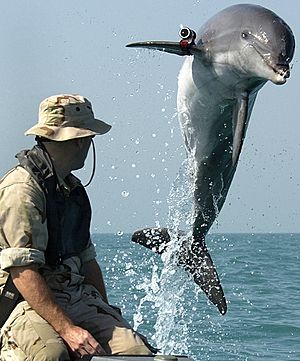
The military of the United States and Russia train bottlenose dolphins as military dolphins for war. The dolphins' jobs include finding sea mines and spotting enemy divers. The program in the United States, called the U.S. Navy Marine Mammal Program, is in San Diego.
Dolphins in Books and TV
The popular TV show Flipper showed a bottlenose dolphin who was friends with two boys. Flipper was like a sea-going Lassie. He understood English and was a hero. Two more TV shows have been made since then.
Bottlenose dolphins have also been in other TV shows and movies. These include Wonder Woman, Highway to Heaven, Dolphin Cove, seaQuest DSV, The Penguins of Madagascar, Zeus and Roxanne, Bermuda Triangle, Dolphin Tale, and Dolphin Tale 2. Many scenes with humans and dolphins are filmed in the Florida Keys at the Dolphin Research Center.
Bottlenose dolphins have also appeared in books. In The Hitchhiker's Guide to the Galaxy, dolphins try to warn humans that Earth will be destroyed. But their actions were misunderstood as playful acrobatics. Bottlenose dolphins are main characters in Anne McCaffrey's Dragonriders of Pern series, especially The Dolphins of Pern. Bottlenose dolphins are in the science fiction video game series Ecco the Dolphin. Delphineus, a dolphin, is a character in the video game EcoQuest: The Search for Cetus. He helps a boy named Adam find the sea king Cetus (a sperm whale) and clean up the underwater world. Bottlenose dolphins were mentioned in various Star Trek novels. Their job was to be navigation specialists on different Federation starships.
T.D., the Miami Dolphins' mascot, uses the bottlenose dolphin as its team logo.
Writings by Aristotle, Oppian, and Pliny the Elder all mention facts about bottlenose dolphins.
What Dangers Do Dolphins Face?
Bottlenose dolphins are still caught or killed in dolphin drive hunts. This is for their meat, to reduce competition for fish, and to capture them for marine parks. Bottlenose dolphins often swim with tuna. They can get caught in tuna nets, which can kill them. Because people worried about the dolphins, many stopped buying tuna. This was called a boycott. These boycotts led to "dolphin-safe" labels for fishing methods that do not harm dolphins.
A man-made chemical called perfluorooctanesulfonic acid (PFOS) might be harming the immune system of bottlenose dolphins. A recent study found high levels of cadmium and mercury in bottlenose dolphins from South Australia. These high levels were linked to kidneys that did not form correctly. This shows that high amounts of heavy metals can be bad for a dolphin's health.
How Are Dolphins Protected?
Bottlenose dolphins are not endangered. However, some specific groups are threatened. This is due to different environmental changes. The dolphin group in the Moray Firth in Scotland has about 190 dolphins. They are threatened by harassment, injuries, water pollution, and less food. Also, a separate group in Doubtful Sound, New Zealand, is shrinking. This is because calves are being lost due to more warm freshwater flowing into the fjord. One of the largest coastal groups of bottlenose dolphins in Shark Bay, Western Australia, is expected to stay stable. There has been little change in deaths over time there.
Images for kids
See also
 In Spanish: Tursiops para niños
In Spanish: Tursiops para niños



